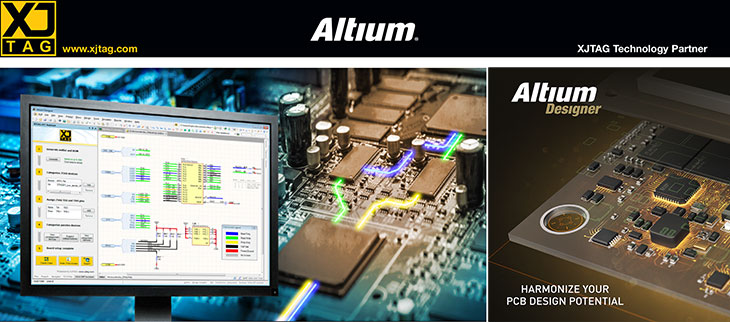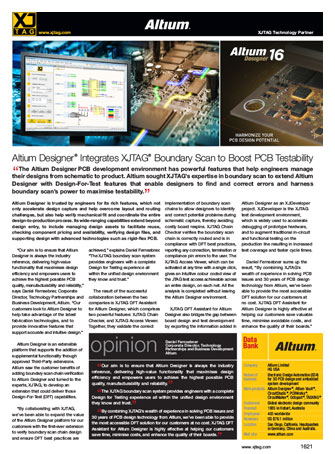The Altium Designer® PCB development environment has powerful features that help engineers manage their designs from schematic to product. Altium sought XJTAG’s expertise in boundary scan to extend Altium Designer with Design-For-Test features that enable designers to find and correct errors and harness boundary scan’s power to maximise testability.
Altium Designer is trusted by engineers for its rich features, which not only accelerate design capture and help overcome layout and routing challenges, but also help verify mechanical fit and coordinate the entire design-to production process. Its wide-ranging capabilities extend beyond design entry, to include managing design assets to facilitate reuse, checking component pricing and availability, verifying design files, and supporting design with advanced technologies such as rigid-flex PCB.
“Our aim is to ensure that Altium Designer is always the industry reference, delivering high-value functionality that maximises design efficiency and empowers users to achieve the highest possible PCB quality, manufacturability and reliability,” says Daniel Fernsebner, Corporate Director, Technology Partnerships and Business Development, Altium. “Our customers look to Altium Designer to help take advantage of the latest fabrication technologies, and to provide innovative features that support accurate and intuitive design.”
Altium Designer is an extensible platform that supports the addition of supplemental functionality through approved third-party extensions. Altium saw the customer benefits of adding boundary scan chain verification to Altium Designer and turned to the experts, XJTAG, to develop an extension that could deliver those Design-For-Test (DFT) capabilities.
“By collaborating with XJTAG, we’ve been able to expand the value of the Altium Designer platform for our customers with the first-ever extension to verify boundary scan chain design and ensure DFT best-practices are achieved,” explains Daniel Fernsebner. “The XJTAG boundary scan system provides engineers with a complete Design for Testing experience all within the unified design environment they know and trust.”
The result of the successful collaboration between the two companies is XJTAG DFT Assistant for Altium Designer, which comprises two powerful features: XJTAG Chain Checker, and XJTAG Access Viewer. Together, they validate the correct implementation of boundary scan chains to allow designers to identify and correct potential problems during schematic capture, thereby avoiding costly board respins. XJTAG Chain Checker verifies the boundary scan chain is correctly routed and is in compliance with DFT best-practices, reporting any connection, termination or compliance pin errors to the user. The XJTAG Access Viewer, which can be activated at any time with a single click, gives an intuitive colour-coded view of the JTAG test access achievable across an entire design, on each net. All the analysis is completed without leaving the Altium Designer environment.
XJTAG DFT Assistant for Altium Designer also bridges the gap between board design and test development by exporting the information added in Altium Designer as an XJDeveloper project. XJDeveloper is the XJTAG test-development environment, which is widely used to accelerate debugging of prototype hardware, and to augment traditional in-circuit and functional testing on the production line resulting in increased test coverage and faster cycle times.
Daniel Fernsebner sums up the result, “By combining XJTAG’s wealth of experience in solving PCB issues and 30 years of PCB design technology from Altium, we’ve been able to provide the most accessible DFT solution for our customers at no cost. XJTAG DFT Assistant for Altium Designer is highly effective at helping our customers save valuable time, minimise avoidable costs, and enhance the quality of their boards.”







